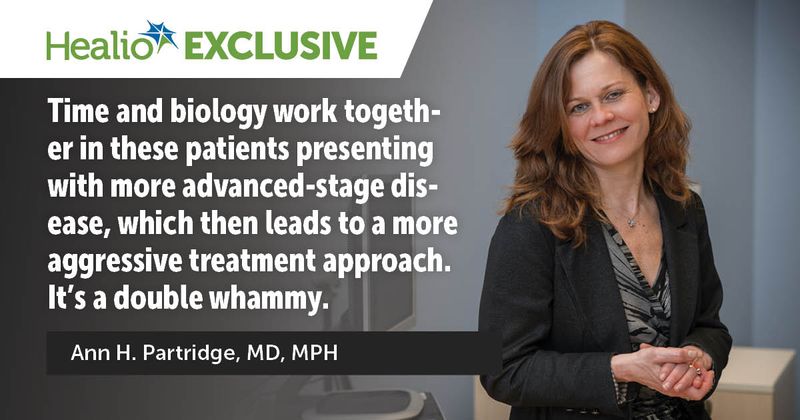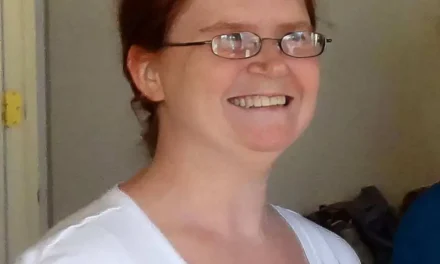September 25, 2023
11 min read
Source/Disclosures
Published by:
Disclosures:
Brantley, Fisher, Partridge and Teplinsky report no relevant financial disclosures.
Breast cancer accounts for nearly one-third of new cancer diagnoses among women in the United States.
However, the vast majority of these cancers — an estimated 93% to 96% — occur among women aged older than 40 years.

Consequently, younger women are not well-represented in most research, including clinical trials.
This is concerning for two key reasons.
First, breast cancer incidence among younger women — which remained relatively stable from 2000 to 2016 — has increased 2.2% annually since then, according to SEER statistics.
Second, early-onset breast cancer often is diagnosed at more advanced stages and associated with worse outcomes.
Because younger women face unique challenges during treatment and survivorship, using data from the broader breast cancer population to inform decision-making is far from optimal, according to Ann H. Partridge, MD, MPH, founder and director of the Program for Young Adults with Breast Cancer and director of the adult survivorship program at Dana-Farber Cancer Institute.
“The average age at [breast cancer] diagnosis in North America is 61 years. Applying that lens to a 25-year-old or a 35-year-old may not reflect the same risks and benefits from any given intervention,” Partridge told Healio. “That is why we decided to seek to learn more [about] this younger population and created a cohort of younger women with breast cancer to study their issues over time — ranging from the psychosocial to biomedical and everything in between.”
The Young Women’s Breast Cancer Study (Helping Ourselves, Helping Others) — a multi-institutional cohort study Partridge launched in 2006 — has enrolled more than 1,300 women aged 40 years or younger with breast cancer.
Investigators have examined disease biology and genetic risk factors, as well as other issues particularly important to young adults, such as sexual functioning, fertility, genetic testing and body image.
“From our research and the work of others, we now know young women are more likely to present with more advanced-stage breast cancer because they generally do not undergo population-based screening. They also are more likely to have larger-sized tumors, more lymph node involvement, and more aggressive types, such as triple-negative or HER2-positive disease,” Partridge said. “Time and biology work together in these patients presenting with more advanced-stage disease, which then leads to a more aggressive treatment approach. It’s a double whammy for these women.”
Healio spoke with breast cancer specialists about the importance of this research effort, the insights it has yielded so far, the need for deeper understanding of disease biology among young women, and other ongoing areas of emphasis for investigators.
‘Recognition of suffering’
Two decades ago, data related to younger patients with breast cancer were limited.
“The recognition that our young patients with breast cancer appeared to be in clinic suffering the most — both medically from the disease and treatments, as well as emotionally in terms of adjusting to the diagnosis and treatment and to either survivorship or living with disease — led us to conduct the study,” Partridge told Healio. “It was both the recognition of suffering, as well as the recognition that we didn’t have enough data to inform a lot of the decisions for our youngest patients and the unique issues they face, [such as] fertility, perimenopause [or] higher likelihood of harboring genetic mutations.”
Initially, the Young Women’s Breast Cancer Study focused considerably on fertility. A survey of women who enrolled showed about 40% expressed interest in future fertility, but only 10% of those interested pursued fertility preservation strategies at the time of diagnosis.
About 10% of patients at least 5 years from diagnosis went on to have a pregnancy, Partridge said.
“This goes to show the frequency at which this is an issue,” she said. “It is common, and yet relatively few women are having babies. Trying to help these patients manage those concerns and understand why they are — or are not — having pregnancies can help us inform the decisions people make when they’re diagnosed.”
Partridge and colleagues also have focused on localized treatment.
For example, they assessed decision-making and outcomes based on whether women opted for mastectomy vs. lumpectomy followed by radiation.
“[We looked at] how that impacts the way they feel about themselves and how they feel about their bodies, [as well as] anxiety and disease outcomes,” Partridge said.
Findings showed younger patients who undergo bilateral mastectomy — even for unilateral disease — typically are more anxious and exhibit poorer sexual functioning and body image.
“That information can help women make treatment decisions,” Partridge said. “It does not appear that anxiety gets better over time for these patients from the pursuit of more aggressive surgery when they don’t need it.”
Unique disease biology
Study findings also showed biological differences in breast cancer between younger vs. older women.
“We have examined a genomic expression assay in our youngest patients to see whether it is predictive and … indeed it is,” Partridge said. “Experts have historically been reluctant to use genomic tests [for] our youngest patients, but our data provide additional reassurance that it does appear helpful.”
Genetic analyses of cohort participants showed younger women are more likely to harbor germline predisposition to breast cancer — not only due to BRCA1 or BRCA2 mutations, but also due to alterations in PALB2 or other less common but high-risk predisposing genes, Partridge said.
Partridge and colleagues also assessed whether younger women were more likely to have clonal hematopoiesis of indeterminate potential (CHIP), which can increase risk for heart disease and secondary malignancies.
“They didn’t appear to have high rates of CHIP, so that was a ‘good news’ study,” Partridge said.
A clearer understanding of what distinguishes breast cancer biologically among young vs. older patients may help oncologists better exploit those differences to guide therapeutic decision-making and improve outcomes, according to Julie G. Fisher, MD, oncologist at Atrium Health Levine Cancer Institute and co-director of the institute’s Sandra Levine Young Women’s Breast Cancer Program.
“With any research, we first start with the need to understand what we are up against,” Fisher told Healio. “Once we define that, we can hopefully identify treatments that are going to be more effective.
“We currently treat stage for stage, tumor for tumor, and we treat breast cancer among younger and older patients similarly,” Fisher added. “If we have a deeper insight into the unique biological fingerprints, that might give us something specific to focus on in terms of seeking treatments. That is what The Young Women’s Breast Cancer Study aims to do.”
Second primary breast cancer
Another component of the study aims to better understand risk for second primary breast cancer among young women.
Prior research showed this risk is higher for those diagnosed with primary breast cancer prior to age 40. However, data are limited regarding the association between risk for secondary primary breast cancer and clinical risk factors, particularly those related to germline risk.
Young women with breast cancer are more likely to opt for bilateral mastectomy upon initial diagnosis, despite having no known risk factors that would suggest a need for the surgery, according to Kristen D. Brantley, PhD, postdoctoral research associate at Dana-Farber and Harvard T.H. Chan School of Public Health.
“We conducted [a] substudy to better understand the true risk for a second primary breast cancer for young patients with breast cancer with the goal of helping to better inform treatment decisions,” Brantley told Healio. “Our second main goal was to differentiate between women who are at high genetic risk for second primary breast cancers [and] those at low genetic risk. These two groups need to be separated when evaluating breast cancer outcomes.”
The analysis included 1,302 women in The Young Women’s Breast Cancer Study, all of whom had been diagnosed with breast cancer between 2006 and 2016.
Brantley and colleagues compared clinical and treatment characteristics between those who developed a second primary breast cancer and those who did not.
Researchers presented their findings at this year’s ASCO Annual Meeting.
After median follow-up of 9.9 years, 2.5% of women (n = 17) developed a second primary breast cancer. Women who developed second primary cancer appeared more likely than those who did not to have in situ disease as their primary breast cancer (24% vs. 6%) and be of Ashkenazi descent (12% vs. 5%).
The majority (84%) underwent genetic testing, and most of those (94%) were noncarriers of pathogenic variants.
Of those who had undergone genetic testing, 12 (2.2%) of the noncarriers developed second primary breast cancer compared with three (9.1%) of the carriers.
“The risk for developing a second primary breast cancer was more than four times lower among women who did not have a germline pathogenic variant that predisposed them to breast cancer,” Brantley said. “That was most often a BRCA1 or BRCA2 mutation. … The probability of having a second breast cancer event was about 1.5% for noncarriers within 5 years of diagnosis, which reflects the true risk for most patients with breast cancer.”
This underscores the importance of germline genetic testing so young patients with breast cancer know their true risk for a second primary breast cancer. Currently, only about one-quarter of people with breast cancer undergo genetic testing, Brantley said.
Brantley and colleagues also determined patients initially diagnosed with in situ breast cancer — as opposed to invasive breast cancer — had a nearly fivefold higher risk for a second primary breast cancer.
“This finding needs more thorough investigation with larger studies, but it may indicate a beneficial impact of endocrine therapy, which is less often used among [patients with in situ breast cancer],” Brantley said. “Overall, these data help oncologists communicate effectively with patients about their future risk for a second primary breast cancer, which will help to inform treatment decisions at the time of primary diagnosis.”
In the absence of a genetic mutation, risk for second primary breast cancer is considerably low, Eleonora Teplinsky, MD, head of breast medical oncology and clinical assistant professor of medicine at Icahn School of Medicine at Mount Sinai, told Healio.
“This is important because very often women are making decisions regarding a single mastectomy vs. a bilateral mastectomy due to concerns for a second primary breast cancer,” Teplinsky said. “This study is really important [for] providing information that shows that incidence is quite low. There’s still more work to be done, but this may help some women make decisions about the type of breast cancer surgery they choose to undergo.”
Distribution of TILs
Prior research established an association between increased tumor-infiltrating lymphocytes (TILs) and better prognosis among women — regardless of age — with triple-negative breast cancer. However, the role of TILs remains unclear among women aged 40 years or younger with hormone receptor-positive, HER2-negative disease.
Patients aged 40 years or younger diagnosed with breast cancer have worse prognoses than older patients, and recent data suggest this risk predominantly occurs among those with hormone receptor-positive, HER2-negative disease, Megan E. Tesch, MD, research fellow in the department of medicine at Dana-Farber Cancer Institute, said during a presentation at this year’s ASCO Annual Meeting.
“However, to what extent this risk stems from age-related biological differences remains poorly understood,” Tesch said. “Therefore, biomarkers are needed that tailor treatment for young patients with this common breast cancer subtype to their unique disease biology.”
TILs are one such emerging biomarker. High levels of TILs have been linked to improved survival and pathologic complete response rates after neoadjuvant treatment — particularly among those with early-stage triple-negative disease, Tesch said.
As part of another substudy of The Young Women’s Breast Cancer Study, Tesch and colleagues assessed the extent and composition of immune infiltration among 390 young women with hormone-positive disease.
Results showed Black women (n = 17) experienced higher expression of stromal CD8-positive (P = .010), FOXP3-positive/CD3-positive (P = .027) and PD1-positive/CD8-positive TILs (P = .043).
Researchers also observed an association between older age and higher expression of CD8-positive (P = .033) and PD1-positive/CD8-positive TILs (P = .031) within stroma, as well as CD3-positive/CD8-negative TILs (P = .046).
“TIL subtypes among young women with hormone receptor-positive tumors varied according to age, race, histologic subtype and grade, demonstrating the biological heterogeneity of this patient subgroup,” Tesch said during her presentation. “Most TIL subtypes appeared associated with improved breast cancer outcomes [among] young patients, including immunostimulatory and immunosuppressive subtypes. This may reflect an overall favorable effect from active antitumor immune responses and concomitant infiltration of immunoregulatory cells as part of a normal feedback loop rather than an isolated immunosuppressive process.”
The findings support further research into the characterization of immune cells and their interactions, which could help refine the prognostic and predictive value of TILs in hormone receptor-positive breast cancer, she added.
“Our data also indicate that young patients may benefit from further development of immune biomarkers to potentially improve their risk stratification and enable tailoring of escalated or de-escalated treatment strategies among these patients,” Tesch said.
The observation that TILs subtypes appeared associated with improved breast cancer outcomes among young patients may allow for development of biomarkers that improve risk stratification and lead to better therapies for younger patients, Teplinsky said.
“We are in desperate need of stratifying who is going to do better and who is going to potentially fare worse so that we can tailor and adapt their treatment accordingly,” Teplinsky said. “This study goes a long way in starting to think about that.”
Looking ahead
Experts with whom Healio spoke agreed that efforts to better understand disease biology among young women with breast cancer — and learning more about the unique challenges they face — ultimately will improve outcomes for this population.
“We have certainly seen improvements with regard to fertility issues among these patients over the years. On top of that, there are now better data to inform treatment decisions,” Partridge said. “Our response rates to follow-up surveys that we are conducting are still robust, so we are just hitting our stride. We have a median follow up of about 10 years, so we’re starting to have some nice analyses that are looking at outcomes beyond a few years. We will try to keep going as long as our [institutional review board] allows and the women continue to participate.”
Brantley said she hopes this study will provide oncologists with knowledge about how to best treat and care for young women with breast cancer to minimize patient burden in the long-term.
“We are particularly looking at how we can help them in their treatment journey and whether we can avoid unnecessary surgeries and medications,” Brantley said. “We want our patients to have a better experience, but also ensure that they have the same survival and same ability to recover from the breast cancer.”
Studying a targeted population will allow for a better understanding of how to improve some of the concerns and issues that young patients face, Teplinsky said.
“We know that treating all breast cancers the same doesn’t work,” she said. “There are cohorts and populations of women with breast cancer that have inferior outcomes and, until we figure out the biological reasons for that, we can’t begin to develop new targets and therapeutics to try to improve outcomes.
“We cannot continue to do the same thing that we’ve been doing, because we see time and time again in studies that young women with breast cancer are a completely different population,” Teplinsky added. “Their cancers behave differently biologically and we have to get to the bottom of that.” – by Jennifer R. Southall
References:
- American Cancer Society. Breast Cancer Facts & Figures 2022-2024. Available at: https://www.cancer.org/content/dam/cancer-org/research/cancer-facts-and-statistics/breast-cancer-facts-and-figures/2022-2024-breast-cancer-fact-figures-acs.pdf. Accessed Aug. 11, 2023.
- American Cancer Society. Key statistics for breast cancer. Available at: https://www.cancer.org/cancer/types/breast-cancer/about/how-common-is-breast-cancer.html. Accessed Aug. 11, 2023.
- BreastCancer.org. Breast cancer facts and statistics. Available at: https://www.breastcancer.org/facts-statistics. Accessed Aug. 11, 2023.
- Brantley KD, et al. Abstract 10503. Presented at: ASCO Annual Meeting; June 2-6, 2023; Chicago.
- Collins LC, et al. Breast Cancer Res Treat. 2011;doi:10.1007/s10549-011-1872-9.
- NIH. National Cancer Institute Surveillance, Epidemiology, and End Results Program. Breast [cancer]: Recent trends in SEER age-adjusted incidence rates, 2000-2020. Available at: https://seer.cancer.gov/statistics-network/explorer/application.html. Accessed Aug. 11, 2023.
- Partridge AH, et al. J Clin Oncol. 2016;doi:10.1200/JCO.2015.65.8013.
- Rosenberg SM, et al. Psychooncology. 2013;doi:10.1002/pon.3221.
- Ruddy KJ, et al. Cancer. 2014;doi:10.1002/cncr.28287.
- Tesch ME, et al. Abstract 500. Presented at: ASCO Annual Meeting; June 2-6, 2023; Chicago.
For more information:
Kristen D. Brantley, PhD, can be reached at kbrantley@g.harvard.edu.
Julie G. Fisher, MD, can be reached at julie.fisher@atriumhealth.org.
Ann H. Partridge, MD, MPH, can be reached at ann_partridge@dfci.harvard.edu.
Eleonora Teplinsky, MD, can be reached at teplel@valleyhealth.com.




